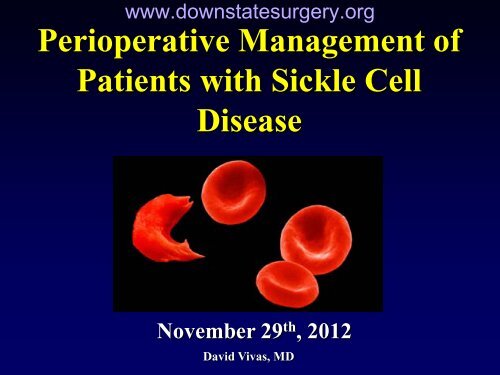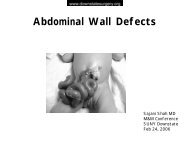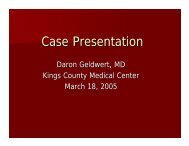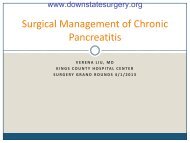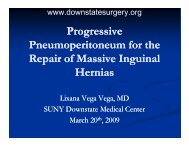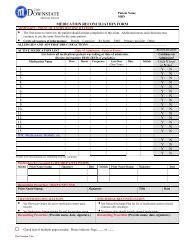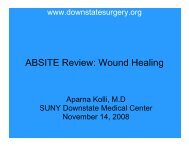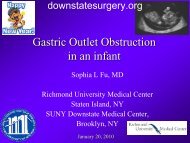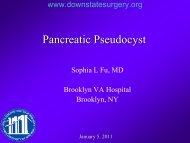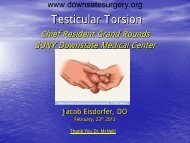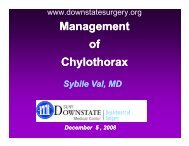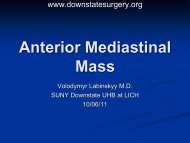Perioperative Management of Patients with Sickle Cell Disease
Perioperative Management of Patients with Sickle Cell Disease
Perioperative Management of Patients with Sickle Cell Disease
You also want an ePaper? Increase the reach of your titles
YUMPU automatically turns print PDFs into web optimized ePapers that Google loves.
www.downstatesurgery.org<strong>Perioperative</strong> <strong>Management</strong> <strong>of</strong><strong>Patients</strong> <strong>with</strong> <strong>Sickle</strong> <strong>Cell</strong><strong>Disease</strong>November 29 th , 2012David Vivas, MD
www.downstatesurgery.orgCase - History• CC: RLQ pain• HPI: 14 y/o female <strong>with</strong> h/o Hg SC presented to ED<strong>with</strong> 4 days h/o abdominal pain, initially diffuse butlater locating to RLQ, associated <strong>with</strong> nausea,vomiting x 4 (nonbilious/nonbloody) and back pain.Patient denied fevers, diarrhea.
www.downstatesurgery.orgCase - History• PMH: SCD, multiple hospital admissions for paincrises in Jamaica• PSH: None• SHx: Patient recently emigrated to the US fromJamaica (2 weeks prior to presentation)•FHx: Father, mother, brother <strong>with</strong> SCD• NKDA
www.downstatesurgery.orgCase - PE• VS: T 102.0, HR: 125, BP: 111/69, RR: 30, SaO2: 99%• AAOx3, In mod. distress• Scleral icterus• CV: RRR, tachycardic• Chest: CTA, b/l• Abdomen: Mod. distension, + BS, s<strong>of</strong>t, diffusely TTP. +guarding on RLQ• Ext: No edema
www.downstatesurgery.orgLabs• CBC: 32.4>11.7/33.8
www.downstatesurgery.orgCase• Patient was admitted to Pediatrics• IV fluids• IV Abx• Pain control• Pediatric Surgery Consult:• Recommend CT abdomen/pelvis IV/PO contrast
www.downstatesurgery.orgCase – CT scan• Acute appendicitis, suspected perforation. Nodiscrete abscess• Moderate splenomegaly. No splenic lesions
www.downstatesurgery.orgCT Scan
www.downstatesurgery.orgCT Scan
www.downstatesurgery.orgCT Scan
www.downstatesurgery.orgF/u Labs• CBC: 13.7>8.8/24.6
www.downstatesurgery.orgCase – Hematology Evaluation• Pediatric Hematology Consultation:• Hb SC patient <strong>with</strong> unusually difficult course inJamaica (No ACS reported) <strong>with</strong> urgent need forlaparotomy• Concern for some sequestration due to drop in Hb,tender liver and spleen, rising Tbili
www.downstatesurgery.orgCase – Hematology Evaluation• Pediatric Heme Consultation Recommendations:• Exchange would be invasive and delay surgery• Transfuse 2 units RBC’s over 2-3 hrs• Avoid over-hydration• Aggressive pulmonary toilet, IS• PICU admission
www.downstatesurgery.orgCase – Operative Course• 2 units <strong>of</strong> PRBC’s were ordered• Patient was taken to OR for emergent appendectomyafter 1 st unit PRBC was being administered
www.downstatesurgery.orgCase – Operative Course• Open Appendectomy• 200 ml pus drained upon entering peritonealcavity• Appendix was necrotic, covered <strong>with</strong> fibrin,perforated• Wound was left open
www.downstatesurgery.orgCase – Post op Course• Patient was extubated and transferred to PICU• NGT• IV Abx (meropenem)• Incentive spirometry• Pain control
www.downstatesurgery.orgCase – Post op CoursePOD # 1- 6 patient improving• Pain well controlled• Febrile on POD # 1• Low grade fever on POD # 3• Afebrile after POD # 3• Bowel function returned POD # 2• Diet advanced to regular by POD # 4• Wound was closed on POD # 4 (delayed primaryclosure)
www.downstatesurgery.orgCase – Post op Course• POD # 7 patient was transferred to regular pediatricfloor• POD # 8 – 10 WBC noted to rise from 6.7 to 13.4• POD # 10 surgical wound was opened• POD # 11• WBC 13.8• CT Abd/Pel: 3.3 x 3.3 cm abscess in LLQ anteriorto psoas muscle
www.downstatesurgery.orgCT Scan
www.downstatesurgery.orgCase – Post op Course• Patient underwent IR drainage <strong>of</strong> intra-abdominalcollection• By POD # 18 patient had finished course <strong>of</strong> Abx andremained afebrile, tolerating a diet, <strong>with</strong> a cleansurgical wound. WBC remained WNL• Patient was D/C home on POD # 19
www.downstatesurgery.orgQuestions?
www.downstatesurgery.org<strong>Perioperative</strong> <strong>Management</strong> <strong>of</strong> <strong>Patients</strong> <strong>with</strong> <strong>Sickle</strong> <strong>Cell</strong> <strong>Disease</strong>1. Background1. Basic Science/Genetics2. Epidemiology3. SC Syndromes Overview4. Major clinical manifestations2. Implications for surgical treatment1. General Considerations2. <strong>Management</strong> Principles
www.downstatesurgery.org<strong>Sickle</strong> <strong>Cell</strong> Dz: Basic Science• Hemoglobin is a tetrameric protein consisting <strong>of</strong> 2 alpha (α)and 2 nonalpha polypeptide chains (ε, γ, β, δ) attached to 4iron-containing heme complexes• <strong>Sickle</strong> cell anemia is a genetic disorder caused by anautosomal co-dominant single gene defect in the β-globinchain <strong>of</strong> HbA, which produces HbS• HbS is formed by the substitution <strong>of</strong> glutamic acid(negatively charged) by valine (nonpolar) in position 6 <strong>of</strong>the β-globin chain <strong>of</strong> hemoglobin
www.downstatesurgery.org<strong>Sickle</strong> <strong>Cell</strong> Dz: Basic ScienceThis has 2 interrelated effects:- The hemoglobin S molecule is unstableand degrades more rapidly- The deoxygenated form is insoluble andprecipitates out <strong>of</strong> solution in the cytosol
www.downstatesurgery.org<strong>Sickle</strong> <strong>Cell</strong> Dz: Basic Science• HbS becomes insoluble at O2 tension in venousrange 5-5.5 kPa• Upon deoxygenation, HbS tends to crystallize andprecipitate• The precipitation and polymerization <strong>of</strong> hemoglobindeforms the cell• The distortions include the characteristic ‘‘sickle’’shape that gives the disease its name
www.downstatesurgery.org<strong>Sickle</strong> <strong>Cell</strong> Dz: Basic Science
www.downstatesurgery.org<strong>Sickle</strong> <strong>Cell</strong> Dz: Basic Science• The term sickle cell anemia (SCA) refers toHbSS disease• SCA occurs if HbS is inherited from bothparents (HbSS genotype)
www.downstatesurgery.org<strong>Sickle</strong> <strong>Cell</strong> Dz: Basic Science• Other forms <strong>of</strong> sickle cell disease may occur ifHbS is inherited from one parent and anotherabnormal hemoglobin, is inherited from theother parent• Hemoglobin C (HbSC)• β-thalassemia (HbSβ-thalassemia)
www.downstatesurgery.org<strong>Sickle</strong> <strong>Cell</strong> Dz: Basic Science• Hemoglobin C is a β-chain variant, most commonin people <strong>of</strong> West Africa• The combination <strong>with</strong> another mutation (ex HbSCdisease) produces symptoms <strong>of</strong> sickle cell disease• The term sickle cell disease (SCD) refers to all <strong>of</strong>the genotypes (HbSS, HbSC, HbSβ-thalassemia)
www.downstatesurgery.orgEpidemiology• SCD is the most common inherited blood disorder inthe United States, occurring in 1 : 2,647 births• SCA accounts for 60% to 70% <strong>of</strong> SCD in the U.S.• SCD occurs in 1 in every 500 African Americans• About 8% <strong>of</strong> African Americans are carriers SCD
www.downstatesurgery.orgEpidemiology• In sickle cell trait (SCT), there is inheritance <strong>of</strong> oneHb S allele (Hb AS)• 25% to 30% <strong>of</strong> neonates in western Africa are carriers<strong>of</strong> the SCT• Approximately 8% <strong>of</strong> African Americans have SCT
www.downstatesurgery.org<strong>Sickle</strong> <strong>Cell</strong> SyndromesOverview• <strong>Sickle</strong> cell disease is characterized clinically by ashortened life span• Median age at death is approximately 42 years for menand 48 years for women• Affected patients characteristically are asymptomaticuntil approximately 4 to 6 months <strong>of</strong> age
www.downstatesurgery.org<strong>Sickle</strong> <strong>Cell</strong> SyndromesOverview• <strong>Disease</strong> manifestations are most severe in patients <strong>with</strong>homozygous Hb SS• SCT (Hb AS) is <strong>of</strong>ten asymptomatic but sickling canoccur at very low oxygen tensions (below 3 kPa)
www.downstatesurgery.org<strong>Sickle</strong> <strong>Cell</strong> SyndromesMajor Clinical ManifestationsAnemia• Chronic, reasonably well-compensated hemolytic anemia,reticulocytosis• Erythrocytes are destroyed randomly, <strong>with</strong> a mean life span <strong>of</strong>17 d (normal: 110 to 120 d)Acute severe anemia:• Splenic sequestration crisis• Aplastic crisis• Hyperhemolytic crisis
<strong>Sickle</strong> <strong>Cell</strong> SyndromesMajor Clinical ManifestationsAcute painful episodes (sickle cell crisis)• Most common• May be precipitated by weather conditions, dehydration,infection, stress, exercise, alcohol consumption, obstructivesleep apneawww.downstatesurgery.org• Up to half <strong>of</strong> episodes have no identifiable cause• Can affect any area <strong>of</strong> the body, <strong>with</strong> the back, chest,extremities, and abdomen being most commonly affected• Can range from trivial to excruciating
www.downstatesurgery.org<strong>Sickle</strong> <strong>Cell</strong> SyndromesMajor Clinical ManifestationsAcute chest syndrome (ACS)• Most common form <strong>of</strong> acute pulmonary disease• Second most common cause <strong>of</strong> hospitalization in SCD andthe leading cause <strong>of</strong> death• Defined as the new appearance <strong>of</strong> an infiltrate <strong>with</strong>pulmonary symptoms in a patient <strong>with</strong> SCD
www.downstatesurgery.org<strong>Sickle</strong> <strong>Cell</strong> SyndromesMajor Clinical ManifestationsAcute chest syndrome (ACS)• Fever, chest pain, and cough• The etiology <strong>of</strong> ACS is multi-factorial• ACS is a frequent postoperative problem• Typically detected 2–3 days postoperatively and last for 8days
www.downstatesurgery.org<strong>Sickle</strong> <strong>Cell</strong> SyndromesMajor Clinical ManifestationsHyposplenism or functional aspleniaInfectionsOsteomyelitisCerebrovascular eventsOsteonecrosis (also called avascular necrosis)Renal complications• Renal failure in up 18 percent <strong>of</strong> patients
www.downstatesurgery.org<strong>Sickle</strong> <strong>Cell</strong> SyndromesMajor Clinical ManifestationsHepatobiliary complications• Acute hepatic ischemia, benign cholestasis,hepatic sequestration crisis, acute and chroniccholelithiasis secondary to pigmented gallstonesPriapism
www.downstatesurgery.org<strong>Sickle</strong> <strong>Cell</strong> and SurgeryGeneral Considerations• SCD patients undergo certain procedures at a higher ratethan the general population• Cholecystectomy• Splenectomy• Femoral head reconstruction due to avascularnecrosis• Joint replacement• Craniotomy due to sub-arachnoid hemorrhage
www.downstatesurgery.org<strong>Sickle</strong> <strong>Cell</strong> and SurgeryGeneral Considerations• Surgery requiring GA may increase risk <strong>of</strong> perioperativesickling and vaso-occlusive events in SCD• <strong>Sickle</strong> cell crises may be precipitated by:• Surgical trauma and inflammatory response to tissueinjury• Hypoxia associated <strong>with</strong> ventilatory depression (e.g.pain, opioids etc)• Dehydration induced by reduced oral fluid intake
www.downstatesurgery.orgSickling Triggers• Hypoxemia• Acidosis• Hypothermia• Dehydration• Low perfusion states• Infections
www.downstatesurgery.org<strong>Sickle</strong> <strong>Cell</strong> and SurgeryGeneral Considerations• The perioperative period is critical for the patient<strong>with</strong> SCD• Factors increasing perioperative risk specificallyfor SCD patients include:• Expected decrease in Pa0 2• Pre-operative opioid tolerance• Fluid compartmental shifts• Disruption in thermoregulation
www.downstatesurgery.org<strong>Sickle</strong> <strong>Cell</strong> and SurgeryGeneral Considerations<strong>Perioperative</strong> complications in SCD• Painful crisis• Acute chest syndrome (ACS)• Hyperhemolytic crisis• Aplastic crisis• Renal complications
www.downstatesurgery.org<strong>Sickle</strong> <strong>Cell</strong> and SurgeryGeneral Considerations<strong>Perioperative</strong> complications in SCDIncidence <strong>of</strong> acute sickle cell exacerbations (n=1079procedures)• 0% for tonsillectomy• 2.9% for hip surgery• 3.9% for myringotomy• 7.8% for intra-abdominal nonobstetric surgery• 16.9% for cesarean section and hysterectomy• 18.6% for dilation and curettageKoshy M, et al. Surgery and anesthesia in sickle cell disease. Blood 1995;86(10):3676–84
www.downstatesurgery.org<strong>Sickle</strong> <strong>Cell</strong> and SurgeryGeneral Considerations• Reversal <strong>of</strong> the sicklingprocess is difficult• Focus is on prevention <strong>of</strong>vaso-occlusive crisis
www.downstatesurgery.org<strong>Sickle</strong> <strong>Cell</strong> and Surgery<strong>Management</strong> Principles1. Pre-operative assessment2. <strong>Perioperative</strong> strategies1. Hydration2. Pain Control3. Oxygenation/Ventilation4. Temperature regulation5. Infection Control6. Peri-operative Blood Transfusions
www.downstatesurgery.org<strong>Sickle</strong> <strong>Cell</strong> and Surgery<strong>Management</strong> PrinciplesPreoperative Assessment and Workup• Identify the frequency, pattern, and severity <strong>of</strong> recentsickle exacerbations, and the presence and extent <strong>of</strong>organ damage• Hemoglobin level, WBC w/diff, reticulocites, LDH, LFT• CXR, Pulmonary function tests, ABG• EKG, or neurologic imaging may be indicated
www.downstatesurgery.org<strong>Sickle</strong> <strong>Cell</strong> and Surgery<strong>Management</strong> PrinciplesHydration• Dehydration is a recognized cause <strong>of</strong> sickle cell–relatedcomplications• <strong>Patients</strong> should be encouraged to drink clear fluids freely untilas close to surgery as possible• Preoperative fasting guidelines have been shortened to allowfor oral intake <strong>of</strong> clear fluid up to 2 hours preoperatively• There is a lack <strong>of</strong> evidence to support admission forintravenous hydration preoperatively beyond that appropriatefor the surgical procedure and the degree <strong>of</strong> renal dysfunction
www.downstatesurgery.org<strong>Sickle</strong> <strong>Cell</strong> and Surgery<strong>Management</strong> PrinciplesPain• In SCD patients pain control is <strong>of</strong> utmost importance for tworeasons• Painful crisis is a common complication <strong>of</strong> SCD that can bebrought on as a result <strong>of</strong> the physiologic stress <strong>of</strong> surgery• <strong>Patients</strong> <strong>with</strong> SCD <strong>of</strong>ten experience some degree <strong>of</strong> chronicpain and may be on a regular analgesia regimen beforehaving an operation
www.downstatesurgery.org<strong>Sickle</strong> <strong>Cell</strong> and Surgery<strong>Management</strong> PrinciplesPain continued..• Increasingly, patients <strong>with</strong> SCD who experience acute paincrisis are treated <strong>with</strong> a PCA pump delivery system for opiates• It is recommended to use a recognized pain assessment scale,such as the visual analogue scale. Pain should be regularlyassessed• Remember that patients <strong>with</strong> SCD may have developedtolerance to some analgesia and may require greater doses thanother patients
www.downstatesurgery.org<strong>Sickle</strong> <strong>Cell</strong> and Surgery<strong>Management</strong> PrinciplesOxygenation• A decrease in oxygenation as well as V/Q mismatching canincrease the risk <strong>of</strong> pulmonary infarction or infection inpatients <strong>with</strong> SCD, increasing the risk <strong>of</strong> ACS• <strong>Patients</strong> should be well oxygenated before and throughoutsurgery, and until fully awake• Respiratory therapy is indicated for all patients undergoinggeneral anesthesia
www.downstatesurgery.org<strong>Sickle</strong> <strong>Cell</strong> and Surgery<strong>Management</strong> PrinciplesOxygenation continued…• Hyperoxygenation is recommended at induction <strong>of</strong> anesthesia• Careful monitoring <strong>of</strong> perioperative oxygen saturation iscrucial• Decreasing oxygen saturations should be promptly assessed bythe physician to detect mucous plugging, evolution <strong>of</strong> the acutechest syndrome, or pulmonary embolism
www.downstatesurgery.org<strong>Sickle</strong> <strong>Cell</strong> and Surgery<strong>Management</strong> PrinciplesTemperature• Hypothermia can cause vasoconstriction and red blood cellsludging, leading to an increase in capillary transit time and therisk <strong>of</strong> vaso-occlusion• During most surgical procedures, patients should be keptwarm• The operative ambient temperature should also be maintained
www.downstatesurgery.org<strong>Sickle</strong> <strong>Cell</strong> and Surgery<strong>Management</strong> PrinciplesInfection Control• <strong>Patients</strong> <strong>with</strong> SCD are generally immunocompromised at ayoung age• Prevention <strong>of</strong> infections in perioperative patients <strong>with</strong> SCD isextremely important because infection is <strong>of</strong>ten a precursor tosickle cell complications• Good hydration, early mobilization, and meticulous handwashing are important and relatively easy to implement• Prophylactic antibiotics should be commenced intraoperativelyand continued until after discharge from the hospital
www.downstatesurgery.org<strong>Sickle</strong> <strong>Cell</strong> and Surgery<strong>Management</strong> PrinciplesPreoperative Blood Transfusions• Erythrocyte transfusion may be indicated:• To augment oxygen-carrying capacity• To prevent acute exacerbations <strong>of</strong> sickle cell disease• Exchange transfusion• To lower the level <strong>of</strong> HbS, usually to around 30%• Simple transfusion <strong>of</strong> 1 or 2 units <strong>of</strong> blood• To raise the overall hemoglobin level to approximately 10g/dL
www.downstatesurgery.org<strong>Sickle</strong> <strong>Cell</strong> and Surgery<strong>Management</strong> PrinciplesPreoperative Blood Transfusions• The case for preoperative transfusion• Improving oxygen delivery• Reduced whole blood viscosity, reducing the risk <strong>of</strong> vasoocclusion• The case against preoperative blood transfusion focuses on therisks• Transmission <strong>of</strong> bloodborne infectious agents• Incidence <strong>of</strong> red blood cell alloimmunization (8% to 50%)and increases <strong>with</strong> the number <strong>of</strong> transfusions
www.downstatesurgery.org<strong>Sickle</strong> <strong>Cell</strong> and Surgery<strong>Management</strong> PrinciplesPreoperative Blood Transfusions• Individualized approach to preoperative bloodtransfusion:• Assess every case individually• If absolutely necessary to transfuse• Patient understands the risks <strong>of</strong> blood transfusion• Use <strong>of</strong> leukocyte-depleted blood
www.downstatesurgery.org<strong>Sickle</strong> <strong>Cell</strong> and Surgery<strong>Management</strong> PrinciplesPreoperative Blood TransfusionsIndividualized approach to preoperative blood transfusion:• Assess the need for transfusion based on the type <strong>of</strong> surgery• Low, moderate, high risk• Length <strong>of</strong> time <strong>of</strong> surgery• Transfusion history• History <strong>of</strong> sickle cell–related complications• General health state <strong>of</strong> the patient
www.downstatesurgery.org<strong>Sickle</strong> <strong>Cell</strong> and SurgeryBlood TransfusionsRCT involving 604 patients compared:• Aggressive transfusion protocol• To reduce the proportion <strong>of</strong> hemoglobin S toless than 30%• Conservative transfusion protocol• To achieve a hematocrits <strong>of</strong> 30%Vichinsky EP, Haberkern CM, Neumayr L, et al. A comparison <strong>of</strong> conservative and aggressive transfusion regimens in the perioperativemanagement <strong>of</strong> sickle cell disease. The Preoperative Transfusion in <strong>Sickle</strong> <strong>Cell</strong> <strong>Disease</strong> Study Group. N Engl J Med 1995;333(4):206–13
www.downstatesurgery.org<strong>Sickle</strong> <strong>Cell</strong> and SurgeryBlood TransfusionsNo significant difference in postoperative sickleexacerbations• The group in the aggressive protocol had a higherincidence <strong>of</strong> transfusion complications such asalloimmunization• Study suggested that aggressive transfusionprotocols to dilute hemoglobin S were no moreeffective than the correction <strong>of</strong> anemia inpreventing complicationsVichinsky EP, Haberkern CM, Neumayr L, et al. A comparison <strong>of</strong> conservative and aggressive transfusion regimens in the perioperativemanagement <strong>of</strong> sickle cell disease. The Preoperative Transfusion in <strong>Sickle</strong> <strong>Cell</strong> <strong>Disease</strong> Study Group. N Engl J Med 1995;333(4):206–13
www.downstatesurgery.org<strong>Sickle</strong> <strong>Cell</strong> and SurgeryBlood TransfusionsCochrane Cystic Fibrosis and Genetic Disorders GroupTrials(Most recent search: 06 October 2011)• Selection criteria• RCT comparing preoperative blood transfusionregimens to different regimens or no transfusionin people <strong>with</strong> SCD undergoing surgeryHirst C,Williamson L. Preoperative blood transfusions for sickle cell disease. Cochrane Database <strong>of</strong> Systematic Reviews 2012, Issue1. Art. No.: CD003149. DOI: 10.1002/14651858.CD003149.pub2.
www.downstatesurgery.org<strong>Sickle</strong> <strong>Cell</strong> and SurgeryBlood TransfusionsResults• 2 studies were identified• Total <strong>of</strong> 920 participants• First study compared an aggressive transfusion regimen to aconservative transfusion regimen in 604 elective operations inpeople <strong>with</strong> sickle cell disease• The conservative regimen was found to be as effective as theaggressive regimen in preventing perioperative complications,and was associated <strong>with</strong> fewer transfusion related adverseeventsHirst C,Williamson L. Preoperative blood transfusions for sickle cell disease. Cochrane Database <strong>of</strong> Systematic Reviews 2012, Issue1. Art. No.: CD003149. DOI: 10.1002/14651858.CD003149.pub2.
www.downstatesurgery.org<strong>Sickle</strong> <strong>Cell</strong> and SurgeryBlood Transfusions• Results• The second study compared a preoperative transfusion group toa group receiving standard care, and did not show an advantageto preoperative transfusion• Conclusions• Conservative therapy appears to be as effective as aggressivetherapy in preparation for surgery• Further research is needed to examine the optimal regimen fordifferent surgical types, and to address whether preoperativetransfusion is needed in all surgical situationsHirst C,Williamson L. Preoperative blood transfusions for sickle cell disease. Cochrane Database <strong>of</strong> Systematic Reviews 2012, Issue1. Art. No.: CD003149. DOI: 10.1002/14651858.CD003149.pub2.
www.downstatesurgery.orgIn Summary• <strong>Sickle</strong> <strong>Cell</strong> <strong>Disease</strong> is a common genetic disorder in theUS especially among African-Americans• SCD has multiple major clinical manifestations thatcan impact the surgical patient, both by increasing theneed for specific surgeries, and by increasing theoverall risk for all surgeries• In the SCD surgical patient, specific attention shouldbe paid to select clinical parameters, such as perioperativeoxygenation, infection control, and Hb levels,to most effectively reduce peri-operative risk
www.downstatesurgery.orgReferences1. Bunn HF. Pathogenesis and treatment <strong>of</strong> sickle cell disease. N Engl J Med 1997; 337:7622. Lottenberg R, Hassell K. An Evidence-Based Approach to the Treatment <strong>of</strong> Adults <strong>with</strong> <strong>Sickle</strong> <strong>Cell</strong> <strong>Disease</strong>.American Society <strong>of</strong> Hematology. Hematology 2005. 2005:58; 10.1182/asheducation-2005.1.583. National Institutes <strong>of</strong> Health. Introduction to Genes and <strong>Disease</strong>: Anemia, <strong>Sickle</strong> <strong>Cell</strong>. National Center forBiotechnology Information. Available at http://www.ncbi.nlm.nih.gov/books/NBK22238/. Accessed May 6, 20094. Centers for <strong>Disease</strong> Control and Prevention. <strong>Sickle</strong> <strong>Cell</strong> <strong>Disease</strong>: Health Care Pr<strong>of</strong>essionals: Data & StatisticsCenters for <strong>Disease</strong> Control and Prevention. Department <strong>of</strong> Health and Human Services. Available athttp://www.cdc.gov/ncbddd/sicklecell/hcp_data.htm. Accessed May 6, 20095. Dix H, New advances in the Treatment <strong>of</strong> <strong>Sickle</strong> <strong>Cell</strong> <strong>Disease</strong>: Focus in <strong>Perioperative</strong> Significance. AANA Journal.August 2001, Vol 69, No 4.6. Koshy M, Weiner SJ, Miller ST, et al. Surgery and anesthesia in sickle cell disease. Cooperative Study <strong>of</strong> <strong>Sickle</strong> <strong>Cell</strong><strong>Disease</strong>s. Blood 1995;86(10):3676–84.7. Firth P. Anesthesia and Hemoglobinopathies. Anesthesiology Clin 27 (2009) 321–3368. Vichinsky EP, Haberkern CM, Neumayr L, et al. A comparison <strong>of</strong> conservative and aggressive transfusion regimensin the perioperative management <strong>of</strong> sickle cell disease. The Preoperative Transfusion in <strong>Sickle</strong> <strong>Cell</strong> <strong>Disease</strong> StudyGroup. N Engl J Med 1995;333(4):206–139. Hirst C,Williamson L. Preoperative blood transfusions for sickle cell disease. Cochrane Database <strong>of</strong> SystematicReviews 2012, Issue 1. Art. No.: CD003149. DOI: 10.1002/14651858.CD003149.pub2.
www.downstatesurgery.orgQuestion 1Acute chest syndromea. Is a major cause <strong>of</strong> death in sickle cellpatientsb. Affects only those sickle cell patients <strong>with</strong>asthmac. Is associated <strong>with</strong> sinus surgeryd. Occurs after a blood transfusion
www.downstatesurgery.orgQuestion 1Acute chest syndromea. Is a major cause <strong>of</strong> death in sickle cellpatientsb. Affects only those sickle cell patients <strong>with</strong>asthmac. Is associated <strong>with</strong> sinus surgeryd. Occurs after a blood transfusion
www.downstatesurgery.orgQuestion 2Individuals <strong>with</strong> sickle cell disease require adaily regimen <strong>of</strong> penicillin because:• a. They are at risk for infection fromencapsulated bacterium• b. They are at an increased risk for bacterialendocarditis• c. They are at increased risk for viral infections• d. Penicillin reduces the incidence <strong>of</strong> renaldysfunction
www.downstatesurgery.orgQuestion 2Individuals <strong>with</strong> sickle cell disease require adaily regimen <strong>of</strong> penicillin because:• a. They are at risk for infection fromencapsulated bacterium• b. They are at an increased risk for bacterialendocarditis• c. They are at increased risk for viral infections• d. Penicillin reduces the incidence <strong>of</strong> renaldysfunction
www.downstatesurgery.orgQuestion 3• The most severe sequelae from a sickle cellcrisis is:• A. Acute chest syndrome, osteomyelitis,cholecystitis• B. Cerebrovascular accident, nephrocalcinosis,osteomyelitis• C. Acute chest syndrome, cerebrovascularaccident, priapism• D. Acute chest syndrome, cerebrovascularaccident, cholelithiasis
www.downstatesurgery.orgQuestion 3• The most severe sequelae from a sickle cellcrisis is:• A. Acute chest syndrome, osteomyelitis,cholecystitis• B. Cerebrovascular accident, nephrocalcinosis,osteomyelitis• C. Acute chest syndrome, cerebrovascularaccident, priapism• D. Acute chest syndrome, cerebrovascularaccident, cholelithiasis


